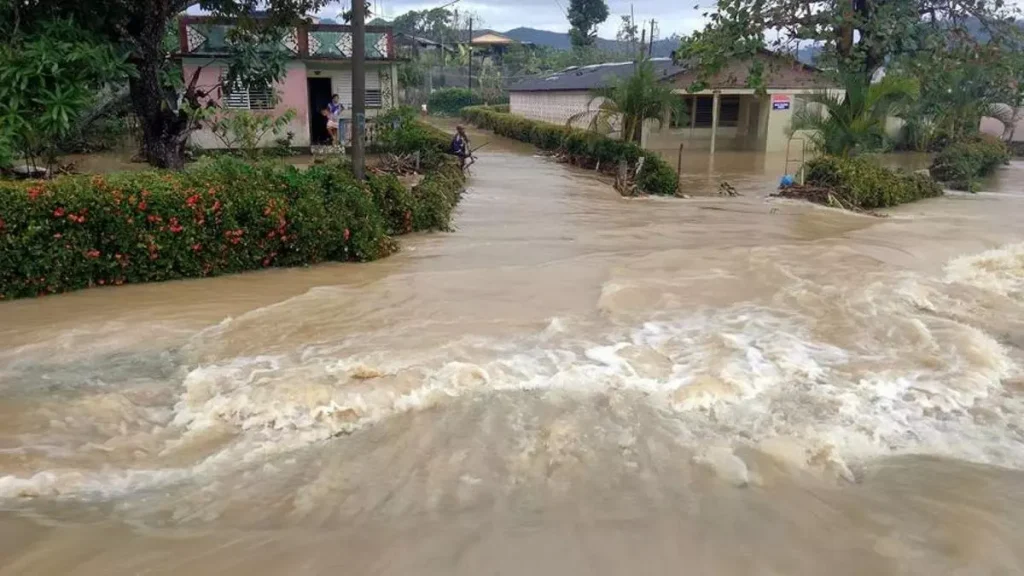Local media reports the overflow of the Miel River and several landslides

![]() 14ymedio, Havana, 25 October 2024 — Baracoa woke up again with floods this Friday, after being incommunicado since last Monday due to the passage of Hurricane Oscar. This time, the heavy rains that have ravaged the municipality of Guantánamo since dawn caused the overflow of the Miel River, whose waters reached several areas of the city and caused some landslides.
14ymedio, Havana, 25 October 2024 — Baracoa woke up again with floods this Friday, after being incommunicado since last Monday due to the passage of Hurricane Oscar. This time, the heavy rains that have ravaged the municipality of Guantánamo since dawn caused the overflow of the Miel River, whose waters reached several areas of the city and caused some landslides.
“Since two in the morning it’s been raining heavily here in Baracoa, and my street is flooded,” a resident told 14ymedio. “What Oscar didn’t do to us, this rain is doing. The water is about to enter the houses, and to top it off, an underground spring erupted on my patio, so we have water everywhere,” he complains. The man reports that, with the soil saturated by the rains left by Oscar, the slightest downpour wreaks havoc.
On Friday, Cuba’s Prime Minister, Manuel Marrero, reported on X that the authorities have begun to evacuate residents of Baracoa and Moa in the eastern province of Holguín. He stated that the Government has begun to mobilize after “the hard experience of the last few days.” “Landslides, floods and damage to homes are reported” in Baracoa, he added. The rainfall of the last few hours has also affected the municipality of Moa.
As reported this morning by the local television station, Primada Visión, the Jamal Weather Station reports intense rains from 1:00 in the morning. By 7:00 am, the cumulative rainfall was 128.8 millimeters (5.1 inches). The showers could last until Sunday. The rains are “related to the presence of an extended trough over the region, the transit of a tropical wave to the south of the territory, together with high values of humidity on the surface and a warm and humid flow from the southern region,” meteorologist Miriam Teresita Llanes told the media.
The television station also reports floods in the neighborhoods and towns of Cabacú – on the outskirts of the city and one of the most affected – La Playa, La Pasada, La Granjita, Reforma Urbana and areas near the Miel riverbed.
According to the Facebook post of Adalberto Moreira, a broadcaster on Radio Baracoa, in some areas of Cabacú, “landslides and floods” were reported.
“Very intense rains continue in Baracoa. Unusual floods in the city and river penetrations into homes are part of a critical panorama,” Primada Visión explained on social networks, where it showed images and videos sent by residents with entire streets flooded and houses with water up to the windows.
Not 48 hours had passed since Miguel Díaz-Canel left Guantánamo, where he visited San Antonio del Sur and promised that the Cubans of those areas were “neither alone nor abandoned.” But the people were again immersed in helplessness, and one resident reproached the leader to his face.
The tasks of the “recovery phase” announced on Thursday by the Civil Defense did not take effect either, and this Friday it was the residents themselves who tried, on their own, to unclog drains to facilitate the runoff.
Although reporting on the rains and sharing the images published by Primada Visión, the state media have not dedicated one line to reporting on the Government’s action plan to reduce damage in Baracoa.
After the passage of Hurricane Oscar, San Antonio del Sur, Imías and Baracoa were left incommunicado by the overflow of rivers and the destruction of several bridges that made it difficult for the authorities and rescuers to reach the municipalities. During those days there were seven deaths confirmed by official media, but large-scale floods and reports from families on social networks indicate that the number could be higher due to the dozens of people who are still missing.
The Minister of Transport, Eduardo Rodríguez Dávila, then reported the formation of a sinkhole that caused a road closure before Imías, leaving the population of Baracoa and Maisí isolated. In addition, in Macambo and La Farola, there were “big landslides” and damage to the San Antonio-Puriales road, whose bridge had one of its supports undermined.
As of Thursday, authorities accounted for at least 1,183 partial collapses and 1,048 partial roof collapses, in addition to 51 total house collapses. These numbers could grow if heavy rains continue in Baracoa.
Residents of Guantánamo province denounced the abandonment of the Government, which kept them uninformed due to the general blackouts on the Island. The news took two days to reach the devastated communities.
Translated by Regina Anavy
____________
COLLABORATE WITH OUR WORK: The 14ymedio team is committed to practicing serious journalism that reflects Cuba’s reality in all its depth. Thank you for joining us on this long journey. We invite you to continue supporting us by becoming a member of 14ymedio now. Together we can continue transforming journalism in Cuba.
